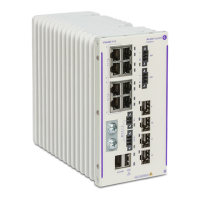Configuring IP IP Defaults
OmniSwitch AOS Release 8 Network Configuration Guide December 2017 page 15-3
IP Defaults
The following table lists the defaults for IP configuration through the ip command.
Quick Steps for Configuring IP Forwarding
Using only IP, which is always enabled on the OmniSwitch, devices connected to ports on the same
VLAN are able to communicate at Layer 2. The initial configuration for all OmniSwitch platforms
consists of a default VLAN 1. All switch ports are initially assigned to this VLAN. If additional VLANs
are not configured on the switch, the entire switch is treated as one large broadcast domain, and all ports
receive all traffic from all other ports.
To forward packets to a different VLAN on a switch, create an IP interface on each VLAN. The following
steps provide a quick tutorial of how to enable IP forwarding between VLANs “from scratch”. If active
VLANs have already been created on the switch, you only need to create IP interfaces on each VLAN
(Steps 5 and 6).
1 Create VLAN 10 with a description (for example, VLAN 10) using the vlan command. For example:
-> vlan 10 name “VLAN 10”
2 Create VLAN 20 with a description (for example, VLAN 20) using the vlan command. For example:
-> vlan 20 name “VLAN 20”
3 Assign an active port to VLAN 10 using the vlan members untagged command. For example, the
following command assigns port 1 on slot 1 to VLAN 10:
-> vlan 10 members port 1/1 untagged
4 Assign an active port to VLAN 20 using the vlan members command. For example, the following
command assigns port 2 on slot 1 to VLAN 20:
-> vlan 20 members port 1/2 untagged
5 Create an IP interface on VLAN 10 using the ip interface command. For example:
-> ip interface vlan-10 address 171.10.1.1 vlan 10
Description Command Default
IP-Directed Broadcasts ip directed-broadcast disable
Time-to-Live Value ip default-ttl 64 (hops)
IP interfaces ip interface VLAN 1 interface.
ARP filters arp filter 0
Note. The operational status of a VLAN remains inactive until at least one active switch port is assigned to
the VLAN. If the ports are connected to an active network device, they are considered active. Non-active
port assignments are allowed, but do not change the operational state of the VLAN.

